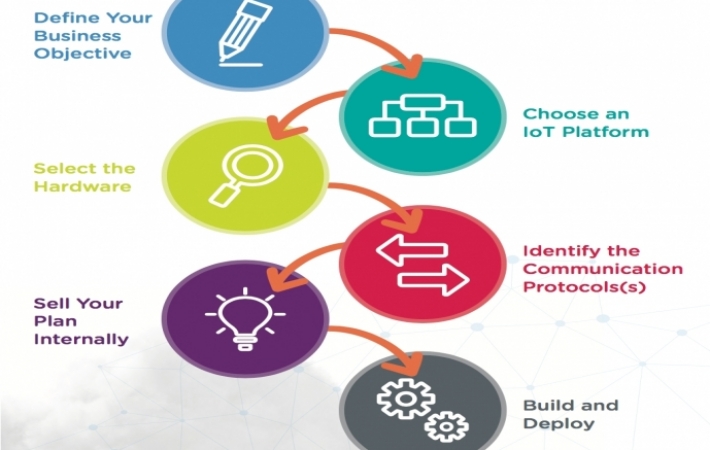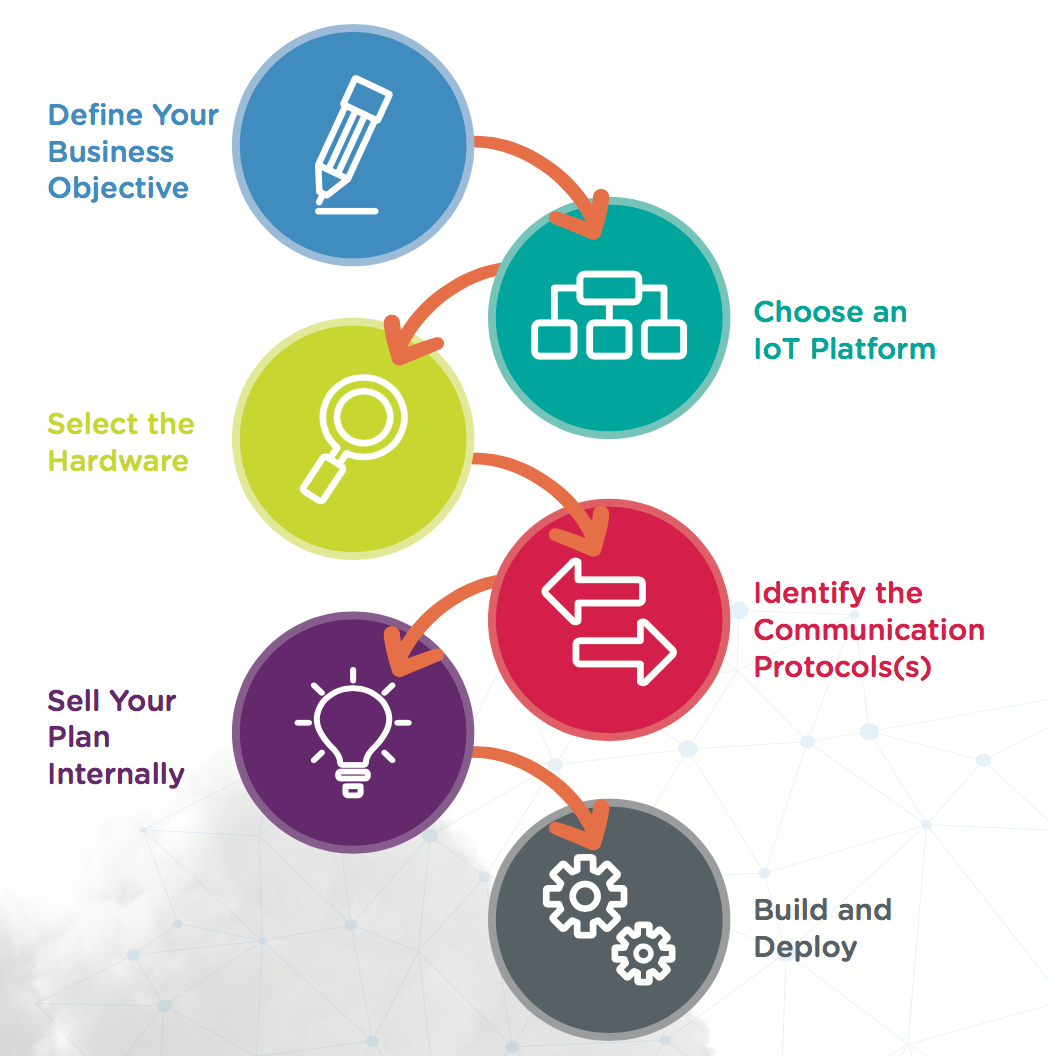
Published on 03/26/2018 | Operations
IoT Project Planning - Best Practices
There’s a great deal to consider when defining your IoT plan, especially if you’re embarking on your first initiative. To help you get started, we’ve consolidated the planning process into a practical, six-step roadmap.

Define Your Business Objective
There are countless ways to leverage IoT to add significant value to your business. Many Sirqul clients have found that the best approach is to start by focusing initially on one or two business objectives.
By focusing your initial effort, you can launch a pilot rapidly, cost effectively and quickly demonstrate business impact. After initial success, you can then consider adding additional functionality and addressing additional business needs based on your learnings.
IoT lends itself really well to both:
Internal Applications that improve business operations, to drive operational efficiencies and reduce costs.
Consumer Engagement Applications that deliver a better user experience or open new revenue streams.
Many companies find it effective to focus first on an internal application, such as an inventory management or monitoring application. You can launch a pilot quickly to show how the solution works, and to demonstrate business value, and then move onto consumer-facing areas that you have identified.
To help you prioritize an initial focus, consider working with an outside IoT partner to help you understand what it would take to implement various solutions, the implementation options, and all the variables and requirements.
Choose an IoT SaaS Platform
At the heart of every IoT implementation is the IoT software platform. The IoT platform is the brain behind the solution – the technology that connects everything together and allows you to both develop and manage the end solution across all systems.
The IoT platform you choose will be one of your key strategic decisions, as it is a long-term investment on which you will evolve your initial solution, and create new solutions that can impact multiple areas of your business.
Key Considerations When Evaluating IoT Platforms
There are several criteria to consider when choosing an IoT platform. Here are the key characteristics to seek.
Open Platform for Integration Flexibility
It is crucial that your platform can be integrated easily with other platforms and technologies, with future technologies that come on the market, as well as your legacy systems. Avoid being locked into a proprietary solution, to help you maintain flexibility, and to easily meet your growing solution requirements.
Scalable for Evolving Needs
You will want a platform that is highly scalable to meet your evolving needs, such as adding new applications, features, devices, users, locations and more. Be aware that while pricing models based on a number of connected devices might be the most cost effective solution for a pilot it may turn into the most cost prohibitive at scale. The platform should also allow you to easily scale up or down your requirements for storage, big data analytics and processing.
Tools for Rapid App Development
A platform that provides a modular approach to app development will enable you to quickly create, test and launch new applications. Pre-built starter kits with modular templates, a robust API library, and a test environment that meet both your current and future needs are key.
Hybrid Capabilities - Edge and Cloud Computing
A hybrid platform will give you the best of both worlds: An onsite service for immediacy of critical data, operational efficiency and localized analytics to provide actionable output in near real-time. And big data analysis and storage in the cloud to help with overall operational and business efficiencies.
Remote Device and Hardware Management
A key to your IoT solution is a platform that provides remote access capabilities for management, reconfigurations, updates and setting controls, especially when processing between local networks and the cloud.
Device/Protocol Agnostic
An open platform can be integrated with nearly any connected device in the same straightforward way. The more agnostic your platform is, the easier it is to create and evolve your solution without restrictions.
Big Data Analytics and Artificial Intelligence
Your IoT platform must be able to address your big data analytics requirements. IoT devices generate continuous streams of data, and you must be able to handle large data volumes, analyze, and perform actions based on that data. Artificial intelligence, machine learning algorithms and predictive analytics are critical components of your IoT solution, and will provide actionable insights beyond basic diagnostics.
Privacy and Security
Security is a vital part of every IoT solution. You must be able to manage end-to-end data encryption at rest and in motion for both user and device authentication. Make sure that your entire solution includes a robust security architecture with role and access management, end point security, and secure transactions between devices, apps and with the cloud.
Trigger and Action Management
Your IoT platform should drive engagement by employing rules-based, data-driven triggers that enable “smart” actions. Rules engines should be able to handle the logic creation of “if-then” statements with multiple object types and combination of queries.
Select Hardware and Devices
IoT hardware is a broad category, with several device applications, ranging from user devices, such as wearables, to sensors that monitor nearly anything.
There are a wide range of over-the-shelf devices that can address most IoT applications. If the functionality you require is not readily available, there are original design manufacturers (ODMs) that can build a custom device that addresses your needs. Hardware manufacturers should be willing to work with you to define the requirements that will make your software and communication protocols compatible within the device.
There are new hardware devices from numerous vendors becoming available just about every day across several industries, from healthcare to robotics to the home and more. You will want to work with your IoT partners to help you evaluate the various hardware and device solutions in order to determine the best ones for your implementation.
Identify the Communication Protocol(s)
The communications protocol connects your devices to each other, and to your IoT platform. Your solution may require multiple protocols, therefore you will want to ensure that your IoT platform is flexible, to integrate with several of them.
The communication protocols will be based on a range of requirements, which can include:

The amount of data you need, the frequency you need it, and over what distance will help you determine your communications technology.
For example, if you want to read a meter once per month to create a bill, this is a low amount of data at wide time interval and across a huge geography, which lends itself to LPWANs like Ingenu. LPWANs are leveraged in industries and applications such as agriculture, cities, buildings, utilities and gas.
Typically, if you are connecting several low-powered devices like sensors, meters or lights over a larger geographic range, LPWANs can help connect to the internet at significant cost savings of about one dollar per device vs. ten to twenty-five dollars with a longer battery life.
Conversely, if you need to know the traffic flow through your retail store in order to determine product placement and trigger notifications in real-time, cellular networks, Bluetooth or Wi-Fi would work well.
Build and Deploy
There are a range of decisions you will need to make to help you determine the best way to build and deploy your IoT solution. Here are five considerations to think about.
5 Key Considerations
1. Deployment Model
One of your key decisions is how to deploy your IoT platform – on premise, in the cloud, or through a hybrid model. There are advantages to each approach. Much of the decision depends on the type of data you need to store, and your organization’s attitude toward cloud computing. Some of the reasons to consider on-premise deployment range from regulations, to security concerns, to connectivity and speed issues.
Many companies prefer a cloud solution, such as Amazon Web Services, because they can deploy more quickly and at a lower development and maintenance cost, and have an agile, scalable platform that allows them to start small and add or subtract new devices and data streams as needed. Some companies prefer a hybrid model, due to the limitations of operating in either a solely dedicated or public cloud environment. The hybrid approach offers benefits, such as enhanced security, while leveraging the cost and scalability benefits of the cloud.
2. Development Resources
Will you be using in-house development resources, or will you outsource development of your solution? Some outside development partners will work with your internal team, enabling you to take a hybrid development approach.
3. Hardware
There are a range of considerations to take into account when choosing hardware, from custom development requirements to environmental conditions. Off-the-shelf hardware is available for most IoT applications. If the functionality you need isn’t readily available, you may choose to work with an ODM to build a custom device.
4. Launch Strategy
Should you launch with a limited pilot, or roll out your solution company-wide? As we noted earlier, an effective approach to consider is to start with a pilot that addresses one or two business objectives, and build from there. This gives you the opportunity to launch rapidly, and quickly demonstrate success. Then you can consider adding additional functionality, or launching company-wide.
5. Location Logistics
During your planning phase, it’s important to pay close attention to location logistics associated with equipment installation. Are there environmental issues that need to be considered? Existing materials or equipment that should be addressed? Are there employee or customer factors to take into account?
Selling Your Plan Internally
Your plan is in place, and it’s time to sell it to internal stakeholders. When gaining buy-in, try to think beyond ROI, and show how your IoT solution is strategic to your business. Here are some tips.
Demonstrate Alignment with Strategic Goals
Show how your IoT investment meets strategic goals, keeping in mind that goals are very likely to evolve over time. By focusing on the strategic business requirements that your IoT solution is meant to solve, you’ll be more successful communicating its value.
Communicate Business Results
Make it a priority to communicate the business results your IoT solution aims to achieve. Can your IoT solution grow sales, save money, improve efficiencies, impact your customer relationships?
Communicate Success Factors
How will you measure success? Is it cost or time savings? Acquisition of new customers? Often companies will do a limited pilot and after hitting their goals, will roll out the solution throughout the organization.
Demonstrate Company-Wide Value
Your IoT solution can impact your entire business — not just one or two departments. Demonstrate how your IoT solution adds value throughout your organization.
Show Business Transformation
Communicate how your IoT solution has the potential to facilitate business transformation. What new businesses will your IoT solution open? How will it modernize operations or redefine product offerings?
Communicate Future Opportunities
Help stakeholders understand that the initial solution is just the beginning. Sell the vision; get people excited about how the platform can evolve over time and impact their business areas. Provide future examples and areas that will create new revenue streams.
This guide first appeared on Sirqul.com